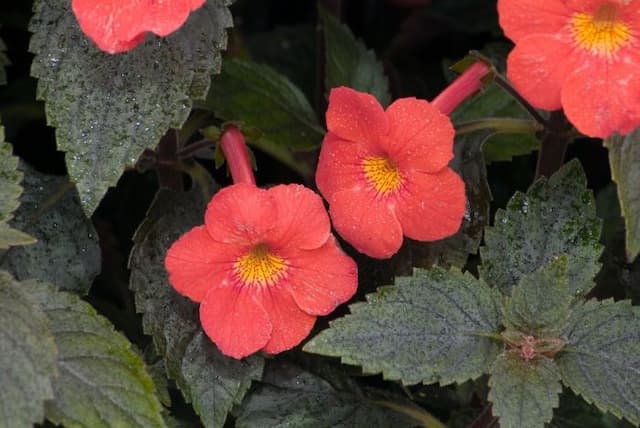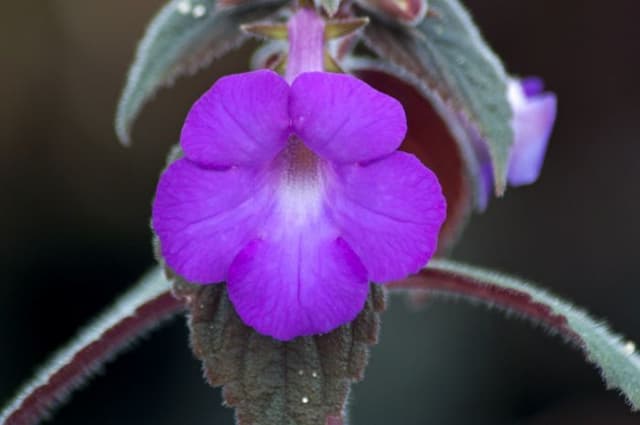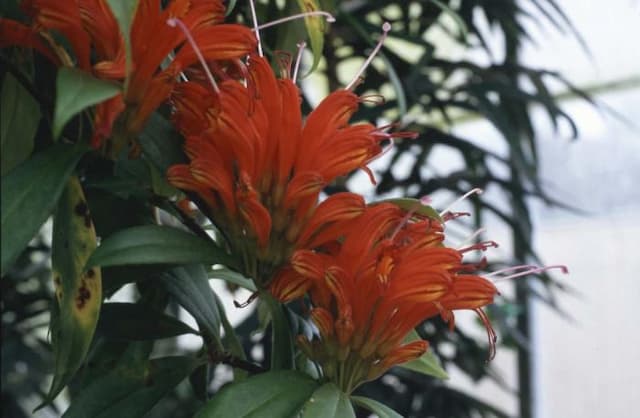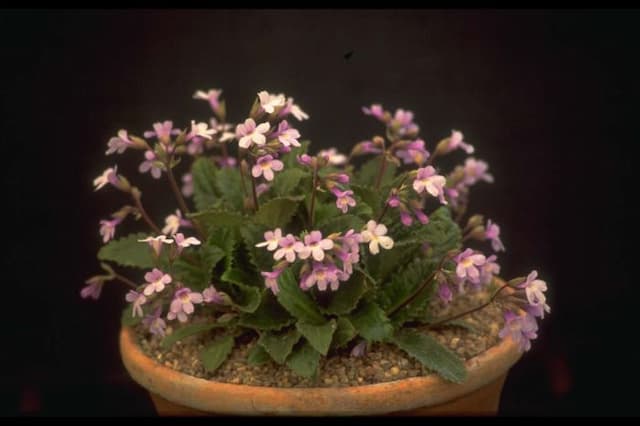Cape Primrose Streptocarpus 'Harlequin Damsel'

ABOUT
The Streptocarpus 'Harlequin Damsel', commonly known as Cape Primrose, boasts a striking appearance with its colorful and patterned blooms. The flowers display a delightful blend of colors, usually with a base of soft pastel hues contrasted by vividly colored throats and intricate, often symmetrical markings. Petals are broad and rounded, sometimes exhibiting ruffled or wavy edges, contributing to the plant's ornamental appeal. Foliage complements the beauty of the blooms, typically comprising of long, velvety leaves that sprawl outward and create a lush backdrop for the flowers. These leaves are deep green, often with a slightly shiny surface. The leaf texture, along with the plant's propensity to produce multiple blossoms, creates a fascinating interplay of softness and vibrancy. Cape Primrose flowers stand atop slender, erect stems that rise gracefully from the base of the plant, providing a platform for the blooms which beckon the eye with their charming patterns. The overall visual effect of the 'Harlequin Damsel' is one of delicate beauty and complex, painterly strokes of nature.
About this plant
 Names
NamesFamily
Gesneriaceae
Synonyms
Cape Primrose, African Violet Cousin
Common names
Streptocarpus 'Harlequin Damsel'.
 Toxicity
ToxicityTo humans
The Cape Primrose, commonly known as Streptocarpus 'Harlequin Damsel', is generally not considered toxic to humans. There is no significant concern regarding its toxicity, and it is not known to cause poisoning when touched or ingested. However, it's always a good practice to wash hands after handling plants and to avoid ingestion, as individual sensitivity can vary.
To pets
The Cape Primrose, known as Streptocarpus 'Harlequin Damsel', is not listed as toxic to pets by major animal poison control resources. It does not typically pose a risk of poisoning to cats, dogs, or other household pets if ingested. As with any non-food plant, ingestion may cause mild gastrointestinal upset, but serious toxicity is unlikely. If your pet does ingest part of this plant, monitor for any signs of discomfort and consult a veterinarian if symptoms develop.
 Characteristics
CharacteristicsLife cycle
Perennials
Foliage type
Evergreen
Color of leaves
Varies
Flower color
Mixed
Height
1 foot (30 cm)
Spread
1 foot (30 cm)
Plant type
Herb
Hardiness zones
10
Native area
Africa
Benefits
 General Benefits
General Benefits- Easy Care: The Cape Primrose is relatively easy to maintain and can thrive with minimal attention, making it suitable for novice gardeners or those with a busy lifestyle.
- Long Blooming Period: Cape Primrose is known for its ability to bloom for several months, offering a continuous display of flowers throughout its blooming season.
- Attractive Flowers: With its vibrant and distinctively patterned petals, Cape Primrose adds a splash of color and visual interest to any indoor space.
- Compact Size: It is suitable for small spaces such as windowsills and desktops since it doesn't grow very large.
- Variety of Colors: Cape Primrose comes in a wide range of colors and patterns, providing options to suit different tastes and decors.
 Medical Properties
Medical PropertiesThis plant is not used for medical purposes.
 Air-purifying Qualities
Air-purifying QualitiesThis plant is not specifically known for air purifying qualities.
 Other Uses
Other Uses- Artistic inspiration: Streptocarpus 'Harlequin Damsel' serves as a muse for artists and photographers due to its unique patterns and vivid colors, sparking creativity for paintings, drawings, and detailed macro photography.
- Educational tool: The plant can be used in botany classes to teach about hybridization, flowering plant reproduction, and the care requirements of non-conventional houseplants.
- Collectible item: As a part of a specific cultivar group, 'Harlequin Damsel' may be collected by plant enthusiasts who aim to have a complete collection of Streptocarpus hybrids.
- Color reference: The plant's unique coloration may be used by designers as a real-life reference to match home décor elements or in developing color schemes for projects.
- Horticultural competitions: Owners might enter 'Harlequin Damsel' into horticultural shows or contests due to its striking appearance and rarity among typical flowering plants.
- Photoperiod research: Its response to various lengths of daylight may be studied by botanists and horticulturalists interested in the flowering triggers of specific plant species.
- Mood improvement: The vibrant colors and interesting form of 'Harlequin Damsel' can help brighten indoor spaces and improve the mood of those in the surrounding environment.
- Craft projects: Dried or pressed flowers from the plant can be used in crafting projects such as in making bookmarks, greeting cards, or framed botanical art.
- Symbolic gift: Because of its unique beauty, it could be given as a gift to represent rarity and appreciation for special relationships or occasions.
- Seasonal decoration: The 'Harlequin Damsel's' striking blooms can be used to create living decorative arrangements for special events or certain seasons, particularly spring and summer.
Interesting Facts
 Feng Shui
Feng ShuiThe Cape primrose is not used in Feng Shui practice.
 Zodiac Sign Compitability
Zodiac Sign CompitabilityThe Cape primrose is not used in astrology practice.
 Plant Symbolism
Plant Symbolism- Endurance and Persistence: Streptocarpus, also known as Cape Primrose, often symbolizes endurance and persistence due to its ability to thrive with minimal care and its long-lasting blooms.
- Hope and New Beginnings: Cape Primrose's continuous flowering can represent hope and the start of new endeavors or phases in life.
- Charm and Gratitude: The delicate and colorful blossoms of Cape Primrose can symbolize charm and the feeling of gratitude when given as a gift.
 Water
WaterCape Primrose should be watered when the top inch of soil feels dry to the touch. Generally, this may mean watering once a week, but this can vary depending on environmental conditions. Water the plant thoroughly, allowing water to run out of the drainage holes, using roughly 8-16 ounces depending on the size of the pot. Over the course of a month, you may find yourself watering approximately 4 times, adjusting as necessary for humidity and temperature changes.
 Light
LightCape Primrose thrives best in bright, indirect light. It should be placed in a spot where it can receive filtered sunlight, such as by an east- or north-facing window. Direct sunlight can scorch the leaves, so avoid placing it in the harsh afternoon sun.
 Temperature
TemperatureCape Primrose prefers to be kept in a temperature range of 60-75 degrees Fahrenheit and should not be exposed to temperatures below 50 degrees Fahrenheit. The ideal conditions would maintain a consistent temperature within this range, avoiding sudden temperature drops or drafts.
 Pruning
PruningPrune Cape Primrose to promote bushier growth and to remove any spent or yellowing leaves. It's best to prune regularly, snipping just above a leaf node. Pruning is particularly beneficial after blooming, to encourage further flower production. The optimal time to prune is in the spring or just after the plant has finished a flowering cycle.
 Cleaning
CleaningAs needed
 Soil
SoilThe best soil mix for the Cape Primrose is light and well-draining, enriched with organic matter. A mix composed of peat, perlite, and vermiculite in equal parts works well, ensuring good aeration and moisture retention. The ideal soil pH for Cape Primrose should be slightly acidic to neutral, ranging from 6.0 to 7.0.
 Repotting
RepottingCape Primrose should be repotted every year or once it has outgrown its container, which is typically indicated by roots emerging from the drainage holes. This frequent repotting ensures the plant has enough room to grow and fresh soil for continued nutrient uptake.
 Humidity & Misting
Humidity & MistingCape Primrose thrives in moderate to high humidity levels, ideally between 50-60%. If the air is too dry, use a humidifier or place the plant on a water-filled pebble tray to increase the surrounding humidity.
 Suitable locations
Suitable locationsIndoor
Place in bright, indirect light and keep soil evenly moist.
Outdoor
Shelter from direct sun and protect from frost.
Hardiness zone
10-11 USDA
 Life cycle
Life cycleThe life cycle of Streptocarpus 'Harlequin Damsel', commonly known as Cape Primrose, begins with germination from seed, which requires a warm and moist environment. After sprouting, the seedling enters a vegetative growth phase, where a rosette of leaves develops, and the plant matures over several months. As an adult, Cape Primrose produces colorful trumpet-shaped flowers, often in various shades of pink or purple, signaling its reproductive stage which may occur multiple times throughout the year. After pollination, typically by insects, the plant produces seed capsules that twist open when dry, releasing seeds for the next generation. Cape Primrose is a perennial, and with appropriate care including adequate light, water, and fertilizer, it can survive for several years, continuing its cycle through vegetative growth and flowering. When environmental conditions are not favorable, or after a few years, the plant may enter senescence, with both flowering and foliage production declining as it reaches the end of its life cycle.
 Propogation
PropogationPropogation time
Spring-Early Summer
Streptocarpus 'Harlequin Damsel', commonly referred to as Cape Primrose, can be easily propagated through leaf cuttings, and the best time for this is spring or summer when the plant is actively growing. To propagate by leaf cuttings, select a healthy, mature leaf and cut it into horizontal strips about 1 to 2 inches (approximately 2.5 to 5 centimeters) in length, making sure each piece has a vein. Lay the leaf sections on a moist potting mix, barely covering them with the mix. Place the pot or tray in a warm, bright spot out of direct sunlight and maintain the humidity around the cuttings. Roots and small plantlets will emerge from the veins in a few weeks, and once these plantlets have grown large enough to handle, usually after a couple of months, they can be gently separated and potted individually.









